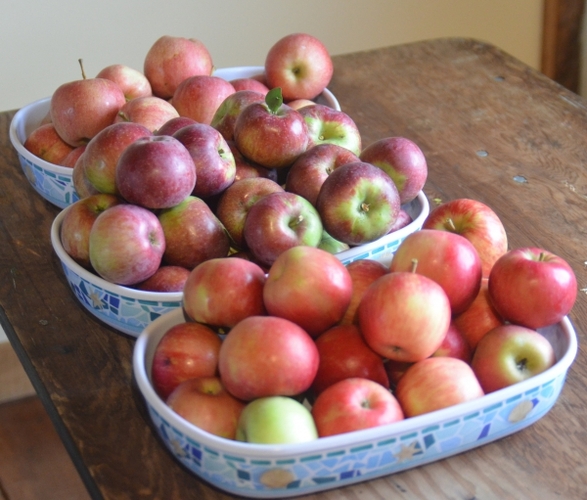Crates and bushels of Vermont apples begin appearing at farm stands in late August and continue the approximate trajectory of fall foliage: as the trees get more colorful, we get more apples.
Bottles of cider abound, as do hand-made pies and candied apples. Locals and visitors roam pick-your-own orchards, stuffing personal harvests into single-handled paper bags.
Agriculture and tourism are two of Vermont's main economic drivers, and apples are but one of the places these two intersect. Apples are crucial to Vermont's economy; according to a 2013 University of Vermont strategic action plan for the state's apple industry, the crop contributes $20 million annually to the state's agricultural economy.
Thus, one could be forgiven for assuming apples are indigenous to Vermont, but Malus domestica originated in Central Asia. According to the Vermont Tree Fruit Growers Association, when European settlers came to Vermont around 1700, they brought apples with them, and during the rest of that century “nearly every farm had an orchard.”
Those apples weren't grown for eating. From about 1700-1865 Vermont was in its “cider apple period,” according to a 1932 report from the Vermont Commission on Country Life's subcommittee on apples.
According to Jason MacArthur, of Marlboro's Whetstone CiderWorks, apples were first grown here principally for fermentation.
“They'd keep so long that way,” he said. “Cider was the early settlers' drink because the water was quickly polluted by the settlers, and became unfit to drink.”
In the mid-1800s Vermont apples went from a popular homestead concern to a thriving industry thanks to a combination of political and cultural developments.
During that time, nomadic travelers, à la Johnny Appleseed, visited orchards statewide, bringing twigs from popular apple trees to graft onto existing trees to cultivate hardy varieties.
That, and the decades of experience Vermont orchardists had gained cultivating apples, yielded better fruit for eating out-of-hand, pickling, baking, pressing into juice, and storing.
The temperance movement upended the apple (cider) cart, too. With alcohol demonized, cider demand withered to almost nothing and wouldn't return in a big way for years.
At this time, Midwesterners began expanding their fields to cultivate more wheat, taking business from the Champlain Valley's thriving grain farms. When it was discovered the Champlain Valley was also ideal for apples, orchards quickly replaced wheat fields.
The advent of railroads also boosted apple sales. Increased access to markets outside the orchardists' local communities provided additional financial incentive to expand apple orchards.
In the late 1800s, the Vermont Tree Fruit Growers Association reports, for-profit orcharding began in earnest: “By 1894, northern Vermont had become one of the most important apple-growing regions of the continent, supplying markets in the United States, Canada, South America, and even Europe.”
According to the Report of the State [Vermont] Board of Agriculture in 1894-95, apple growers were meeting with specialists in fertilization, cultivation, and spraying, and knew the importance of handling fruit carefully for market. The stage was set for the commercial orchard era, which began in 1890, became extensive around 1910, and continues today.
Dwight Miller & Son Orchards happy with quality
One of Windham County's oldest orchards, in operation since at least the Civil War, is Dwight Miller & Son Orchards in Dummerston, run by Read and Malah Miller.
Of this year's crop, Read says, “It's different, which means it's normal.”
“Yield is down,” he says, “but quality is very good.”
Read reports “some very nice fruit. We don't have the bumper crops here but some places in New England do. Every farm and orchard is different. Because we're organic, the market will remain steady for us. Also, local apple buyers are very comfortable with higher quality versus lower quantity.”
Malah explains that “if left to their own devices, apples are a biannual crop. Last year was a phenomenally large crop, so we knew last year that this year's crop would be lower.”
Because their orchard is certified organic, they can't - and wouldn't - use the chemical thinners conventional orchards have at their disposal; this device allows the tree to retain energy for the following year. Conventional growers may see more consistent yields year to year, but quality varies.
Because their crop is smaller this year, Dwight Miller & Son Orchards suspended its “pick-your-own” program.
“The crop is really spread out, which leads to frustration” for people seeking the harvesting experience, Malah says.
Meanwhile, back at the farm stand, Malah reports excellent quality, especially in the Empire variety, which she says “[is] supported by organic growing practices.”
McIntoshes, Honey Crisps, Galas, and Cortlands are available now, with Golden Delicious and Mutsu coming soon, as are “phenomenal Bosc pears,” she says.
Scott Farm's Zeke Goodband: Weather works
Just a few miles south, Scott Farm's Zeke Goodband reports a “good” apple crop, with this summer a boon to apples: “sunny days, cool nights.”
Scott Farm has about 70 types, and Goodband adds a few new apples every year, including Japanese varieties. Their “pick-your-own” program opened for the public in early September and continues daily through October.
Scott Farm participates in the Vermont Foodbank's innovative “Pick For Your Neighbor” program, in which visitors can pay for, and pick, bags of apples. The farm sets those bags aside for the Foodbank, which collects the fruit to distribute to local food-insecure residents.
Pick your own at Green Mountain Orchards
Putney's Green Mountain Orchards is enjoying a thriving pick-your-own season. Green Mountain's website, www.greenmountainorchards.com, reports “Macs, Cortlands, Gala and Honey Crisp are ripe for picking. Many other varieties will be ready soon.”
Weekend hay rides are also in season, the website notes.
On a recent sunny Sunday, the orchard's farm stand was so packed with enthusiastic customers juggling bags of apples, farm-baked pies, and cider donuts that staffers were too busy to chat.
A woman bottling cider smiled and apologized, saying, “We're fried.”
